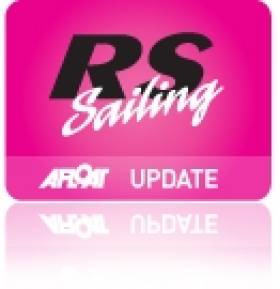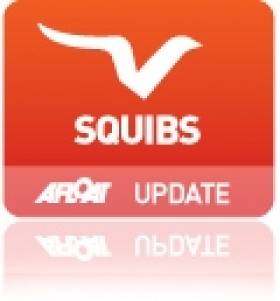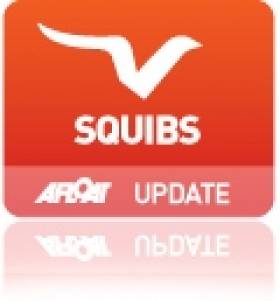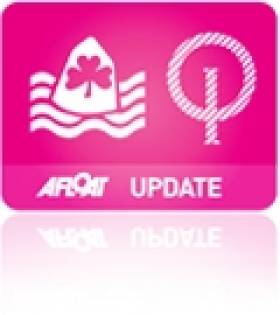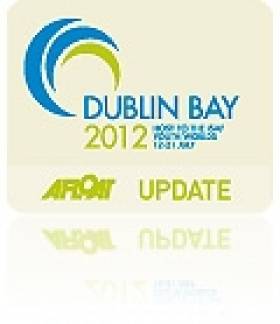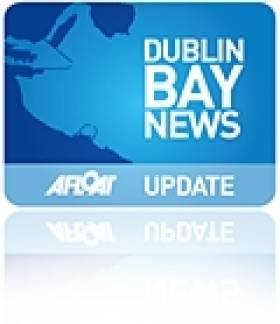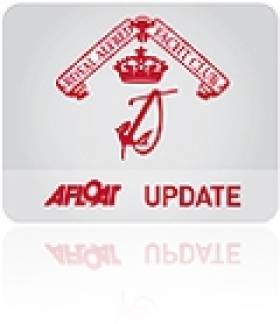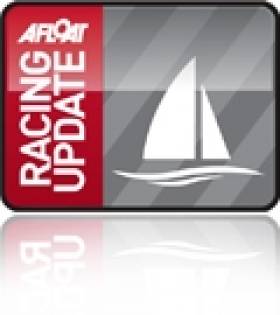Displaying items by tag: Royal St. George Yacht Club
Sportsmanship to the Fore at Dun Laoghaire RS Sprint Event
#rssailing – There was just a whisper of a building breeze as RS fleet launched from the George slip into a rather becalmed Dun Laoghaire harbour. Activity in the harbour built with the breeze during the afternoon with junior winter training for Lasers, Fevas and Oppies, sailing instructor courses, adult learners in Squibs and Picos, all close to the RS racing area. Full results downloadable below as a pdf document.
PRO's Barry O'Neill and Howth's Paul "PK" Kavanagh had stressed the sportsmanship nature of the Sprint event ethos where the start, sailing the shifts and mark rounding would prove so key in such a shifty breeze. As the wind shifted, marks were moved and the reaches tightened, the race course demanded new tactics with each gun. Superb race management allowed 12 races for all competitors with just enough time for a sip of water between the rolling starts. Valerie Kinnear and her team on the finish boat had their work cut out, with only inches and seconds separating the finishers of each fleet.
The start line was short, crowded and noisy with clear air hard to find. In the RS200s, local team Sean Craig and Heather King shot off in to the lead which was maintained throughout the afternoon with 10 out of 12 firsts. 2nd and third were valiantly battled out between 3 Greystones boats, Frank O'Rourke, Graeme Noonan and Sarah Byrne, all of whom had a mixed bag with no discards available, Sarah was squeezed out with Graeme just taking second and Frank third. 15 year olds Aaron Jones & Conor Cleary team managed to take a first from the more experienced helms, making their day and securing the Junior prize. Sarah & Ciara Byrne took first ladies.
In the 400s, Paul McLaughlin and Mick McKinley from Chusendall finally fulfilled their promise with a win over a strong fleet, with consistency combined with aggressive starting technique, which saw them rarely out of the top 4 in the no discard series. Emmet Ryan and bro James were runners up after finding their own personal dead spot of breeze in the final race. Gerry Cannon and Nicola Smyth showed great consistency all day to finish third.
All in all a very well-run event and a fitting climax to a very successful season for the RS classes. Thanks to all at RStGYC for laying on a great day's entertainment.
Royal St. George Pair Win Irish Squib Title on Home Waters
#squib – Racing in the shadow of gale warnings the Irish Squib title hung in the balance on Dublin Bay yesterday but after a a one hour postponement a full race programme was completed. The lead of both race and event changed three time before Aidan O'Connell and Ben O'Donoghue of the Royal St. George YC finally broke away to lift the trophy. Overall results are available to download below as a pdf document.
Royal St. George Teams Top Squib Leaderboard
#squib – With more protests scheduled last night and a gale warning issued for the Irish Sea today there is some doubt about the final race of the Irish Squib championships in Dun Laoghaire this morning. The host club's Aidan O'Connell and Ben O'Donoghue lead by a single point from Vincent Delany and Fergal Gaynor also of the Royal St. George. One point behind in third place in the 23-boat fleet is Kinsale duo Marcus and Megan Hutchinson. Full results after day two are downloadable below as a pdf document.
Dun Laoghaire to Host 2014 Optimist European Championships
#optimist – The International Optimist Dinghy Association yesterday awarded its 2014 European Championship to Dun Laoghaire. The championship was this year attended by 264 sailors from 45 countries.
The choice was made at the Optimist Worlds in the Dominican Republic in competition with the Polish venue of Kamien Pomorski and followed enthusiastic reports of the ISAF Youth World Championship which concluded last week.
The European Championship is one of the largest Optimist events on the annual calendar and the award was made to the Royal St George Yacht Club.
The IODA vote took place at the Optimist World Championships in Boca Chica, Dominican Republic, where five of Ireland's top Optimist sailors are currently competing.
This year's European Championships were held in July in Lignano Sabbiadoro near Venice in Italy, and 265 sailors qualified from 46 nations to take part.
#isafyw12 – In the midst of all the excitement and hullabaloo of the ISAF Youth Worlds a large group of club members are giving up their time to ensure that competing boats are launched and recovered rapidly and without undue stress.
The Royal St George YC has offered all the volunteers an opportunity to get out on the water to view the racing. As part of this initiative, with the express wish that the event leaves as wide a legacy as possible, the forecourt team have set up a "rules coaching" initiative.
Every day the keenest young racing sailors go out on the water in a RIB with an experienced ISA National Judge/Umpire. The future champions are introduced to the particular way in which the judges view the racing. Whilst most sailors might admire how a 420 tacked, how the crew moved rapidly out to a full trapezing position... the judge would be pointing out that the boat, from the moment she passed head to wind until she was on a close-hauled course, was subject to rule 13 "Whilst Tacking" and, having tacked from port to starboard, she had acquired right of way and was obliged to give an approaching port tack boat room to keep clear...
This is also an opportunity for young sailors to learn something of the mechanics of running a serious regatta. Realising that marks are being laid as the competitors sail round the course, listening in on the race committee's discussion as they decide and implement a change of course, in reaction to a change in the wind direction... or shadowing the judges as they view the start line, checking for rule 42 infringements (the young sailors having first read the official ISAF interpretations of the rule regulating methods of propulsion) enriches their understanding of how the race officals work.
By the end of the Championship 45 of Ireland's keenest young sailors, not only from the Royal St George but also groups from Lough Derg and Galway Bay, will have benefited from this experience.
For further information on this initiative contact Gordon Davies 086150122
Dun Laoghaire Yacht Club 2012 Regatta Dates
#REGATTA–The four Dun Laoghaire waterfront Yacht Clubs have released their sailing regatta dates for 2012. In spite of many other racing fixtures on the bay the waterfront regattas remain a traditional favourite starting with the Dun Laoghaire Motor Yacht Club event on Saturday, June 9th.
Dun Laoghaire Yacht Club Regatta Calendar
Dun Laoghaire Motor Yacht Club Regatta 9th June
National Yacht Club Regatta 23rd June
Royal Irish Yacht Club Regatta 30th June
Royal St. George Yacht Club Regatta 7th July
Irish Teams Selected for Team Racing World Championships
After the first round the home team, the "George Gladiators" were demonstrably the leading senior team. They won all their races, and in all but one race finished in first and second place. The "Supertroopers", mainly University of Limerick graduates, were second with 5 wins and UCD1 4 wins. These 3 teams proceded to the second round, sailing each other once. In order to qualify UCD1 needed to beat both other teams. Unfortunately, they lost their first race to the "Gladiators". The "Gladiators" then relaxed, loosing their only race of the day to the Supertroopers, who then beat UCD1.
In the Youth event, Schull1 won 3 races, Schull2 2 races. This was enough to ensure selection.
As a result of these trials the Irish Team Racing Association will be recommending the following teams to represent Ireland (subject to meeting all eligibility requirements) at the ISAF World Team Racing Championships, to be sailed in Schull,West Cork in August:
Ireland 1
Marty O'Leary, Brian Fenlon, Sam Hunt, Jodie-Jane Tingle, Andrew Fowler, Rachel Guy
Ireland 2
Darragh O'Connor, Hannah Herlihy, Kevin Stollard, Rachel O'Brien, George Kingston, Tom Martin
Ireland Youth 1
Connor Miller, Ellen O' Regan, Oisin O'Driscoll, Katie Moynihan, Jay Jay Stacy, Kaspar Snashall
Ireland Youth 2
Fionn Lyden, Tomas O'Sullivan, Darragjh McCormack, Mark Hasset, Pearse O'Flynn, Gleb Romantchik
Royal Alfred Yacht Club Give Notice of 153rd AGM
One of Ireland's oldest sailing institutions, the Royal Alfred Yacht ClubYacht Club, will hold its 153rd AGM on Dun Laoghaire's waterfront at the Royal St. George Yacht Club on Friday 15th April 2011 at 700pm.
For generations the RAYC has been an umbrella organisation, linking yacht racers from the rival harbours of Dun Laoghaire and Howth. It provides an attractive programme of regattas, complementing more local and national events.
The agenda for the meeting is:
1. Apologies
2. In memory of past members
3. Minutes of previous AGM
4. Report from the Commodore
5. Election of Flag Officers
6. Election of Committee Members
7. Finance Report
8. Election of Honorary Auditor
9. Any other business
Dun Laoghaire to Participate in 'Open House' Dublin Week
Several waterfront buildings in Dun Laoghaire Harbour will be made open to the public on Sunday 10 October as part of 'Open House' Dublin Week (7th-10th October). With over 150 tours and workshops, the free event is Ireland's biggest architecture festival, allowing citizens to explore the architecture of their city. Buildings of all types and periods will open up in an event programme which is organised into areas.
In Dun Laoghaire-Rathdown the following buildings below are all open on Sunday 10 October. NOTE: There are other buildings throughout the borough also open to the public for free admission, for information on contact details see bottom of this page.
Commissioners of Irish Lights (CIL), Harbour Road. Tours provide a fascinating insight into the headquarters and work of the Commissioners of Irish Lights. Sunday 10 October (12–5pm). Last tour at 4.30pm. Regular tours. First-come basis. Disabled access.
Harbour Lodge (HQ of Dún Laoghaire Harbour Company), Crofton Road. Built in the neo-classical style, the Georgian house represents the first serious piece of architecture in the town. Sunday 10 October (12–5pm). Last tour at 4.30pm. Regular tours. First-come basis. Disabled access.
Dún Laoghaire-Rathdown County Hall, Marine Road. The council's premises have evolved to comprise the original Town Hall, the adjoining 19th century post office and a late 20th century extension. Sunday 10 October (12-5pm) Last tour at 4.30pm. Regular tours. First-come basis. Disabled access.
(Tour includes the recent Old Town Hall refurbishment by DLRCC Architects Department).
Royal St George Yacht Club, Harbour Road. Founded in 1838, the historic building has been extended with a very contemporary addition. Clad in distinctive copper, this extension is connected to the original club by a glass-covered atrium. Sunday 10 October (12–5pm). Last tour at 4.30pm. Regular tours. First-come basis. Disabled access.
National Yacht Club, Harbour Road. A magnificant Class A listed building which has a design hybrid between a French château and an 18th-century country garden pavilion. Sunday 10 October (2–5pm). Last tour at 4.30pm. Regular tours. First-come basis. Disabled access.
Like most of the tours and events in Open House Dublin, there is no pre-booking required. Entry is FREE and on a first-come basis. For more information about what to expect from your tour or event. Contact: Open House Info Desk Tel: (01) 6165220 and check 'How It Works' by logging onto www.architecturefoundation.ie/openhouse/
70 Squibs Head for Dun Laoghaire
More than 70 Squibs will converge on Dun Laoghaire this weekend for the start of its SF Marinas sponsored UK national championships.
The championships, which are held in Ireland every five years, will see some of the top competitors in this class including Dick Batt, a sailmaker and chief measurer for the Beijing and London Olympics and Irishman Owen Delaney, former Irish Helmsman Champion of Champions.
There is also keen interest from a wide range of clubs including the Royal North of Ireland Yacht Club and Kinsale Yacht Club at the other end of the Island.
Squibs are two-man keelboats measuring seven metres long. They are favoured both as an exciting racing boat, because of their strength and safe design, and as a teaching boat. The Squib Class fleet is one of the largest one-design fleets in Britain and Ireland, with over 810 boats.
The Royal St George Yacht Club says it is delighted to have been selected by the Squib Class to host the 2010 Championship which is a great opportunity to show what Dublin Bay can offer, including its beauty, the varied sailing waters, and the vagaries of the tides.
“We believe Dun Laoghaire, both on and off the water, is a wonderful venue to make Squibs 2010 a memorable event.”
The sponsors of this year’s championship are marine services company, SF MARINA IRELAND, which last month installed new, all concrete, breakwater pontoons at the Royal Saint George Yacht Club, a great addition to the clubs facilities.
SF MARINA IRELAND builds marinas and installs floating pontoons and breakwaters all over the island of Ireland as well as the UK. The directors are Rod and Julie Calder-Potts who trade under the name, Milford Marina Systems, based in Cuffesgrange, Co Kilkenny.
Recently, the company designed and fitted concrete pontoons weighing 1,000 tonnes on the River Liffey to service the Waterbuses Spirit of Docklands and Liffey Voyage. The project consisted of a mega yacht visitors berthing facility on the Custom House Quay and three waterbus landing stages - one at The Point, one south-east of The Ha’Penny Bridge and one at the mouth of George’s Dock on Custom House Quay.
SF MARINA IRELAND is the sole Irish agent for Swedish company SF MARINA specializing in the supply and installation of floating concrete breakwaters that can stand up to the rigorous maritime conditions.
Rod Calder Potts said the company is very proud to be associated with the historic Royal Saint George Yacht Club and with the Squibs National Championships.
He said the installation of the new pontoons last month was the company’s third major installation in Dun Laoghaire Harbour and the eighth in the Dublin Bay area. “We enjoy the challenge of dealing with the difficult Irish tides, winds and waves. It is a pleasure and a privilege dealing with the wonderful sailing clubs around Dublin Bay.” he said.


























